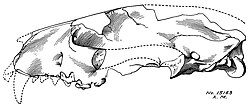Biology:Vassacyon
From HandWiki
Short description: Extinct genus of carnivores
| Vassacyon | |
|---|---|

| |
| Skull of Vassacyon promicrodon | |
| Scientific classification | |
| Domain: | Eukaryota |
| Kingdom: | Animalia |
| Phylum: | Chordata |
| Class: | Mammalia |
| Clade: | Pan-Carnivora |
| Clade: | Carnivoramorpha |
| Clade: | Carnivoraformes |
| Genus: | †Vassacyon Matthew, 1909[1] |
| Type species | |
| †Vassacyon promicrodon Wortman & Matthew, 1899
| |
| Species | |
| Synonyms | |
|
synonyms of species:
| |
Vassacyon ("wasatchian dog") is an extinct genus of placental mammals from clade Carnivoraformes, that lived in North America and Europe from the late Paleocene to early Eocene.[7][8][9] It is considered the largest of the early Eocene mammals.
References
- ↑ W. D. Matthew (1909) "The Carnivora and Insectivora of the Bridger Basin, middle Eocene." Memoirs of the American Museum of Natural History 9:289-567
- ↑ Heinrich, R. E.; Strait, S. G.; Houde, P. (2008). "Earliest Eocene Miacidae (Mammalia: Carnivora) from northwestern Wyoming". Journal of Paleontology 82 (1): 154–162. doi:10.1666/05-118.1. Bibcode: 2008JPal...82..154H. https://www.cambridge.org/core/journals/journal-of-paleontology/article/abs/earliest-eocene-miacidae-mammalia-carnivora-from-northwestern-wyoming/83C6DE571B5ED1F0462018E49445FC16#.
- ↑ Solé, Floréal; Smith, Thierry; De Bast, Eric; Codrea, Vlad; Gheerbrant, Emmanuel (2016). "New carnivoraforms from the latest Paleocene of Europe and their bearing on the origin and radiation of Carnivoraformes (Carnivoramorpha, Mammalia)". Journal of Vertebrate Paleontology 36 (2): e1082480. doi:10.1080/02724634.2016.1082480. ISSN 0272-4634. Bibcode: 2016JVPal..36E2480S.
- ↑ J. L. Wortman and W. D. Matthew (1899.) "The ancestry of certain members of the Canidae, the Viverridae, and Procyonidae." Bulletin of the American Museum of Natural History 12(6):109-138
- ↑ Floréal Solé; Emmanuel Gheerbrant; Marc Godinot (2013). "The "miacids" (Carnivoraformes, Mammalia) from the Early Eocene locality of Le Quesnoy (MP7, France); first occurrence of Vassacyon in Europe". Comptes Rendus Palevol 12 (4): 191–202. doi:10.1016/j.crpv.2013.05.001. Bibcode: 2013CRPal..12..191S.
- ↑ J. L. Wortman (1901.) "Studies of Eocene Mammalia in the Marsh Collection, Peabody Museum." The American Journal of Science, series 4 12:193-206
- ↑ McKenna, Malcolm C.; Bell, Susan K. (1997). Classification of Mammals Above the Species Level. New York: Columbia University Press. ISBN 978-0-231-11012-9. https://books.google.com/books?id=OLYifwU8bqQC&pg=PP9. Retrieved 16 March 2015.
- ↑ J. J. Flynn (1998.) "Early Cenozoic Carnivora ("Miacoidea")." In C. M. Janis, K. M. Scott, and L. L. Jacobs (eds.) "Evolution of Tertiary Mammals of North America. Volume 1: Terrestrial Carnivores, Ungulates, and Ungulatelike Mammals." Cambridge University Press, Cambridge. ISBN:0-521-35519-2
- ↑ Spaulding, Michelle; Flynn, John J.; Stucky, Richard K. (2010). "A new basal Carnivoramorphan (Mammalia) from the 'Bridger B' (Black's Fork member, Bridger Formation, Bridgerian Nalma, middle Eocene) of Wyoming, USA". Palaeontology 53 (4): 815–832. doi:10.1111/j.1475-4983.2010.00963.x. Bibcode: 2010Palgy..53..815S.
Wikidata ☰ Q4781881 entry
 |

